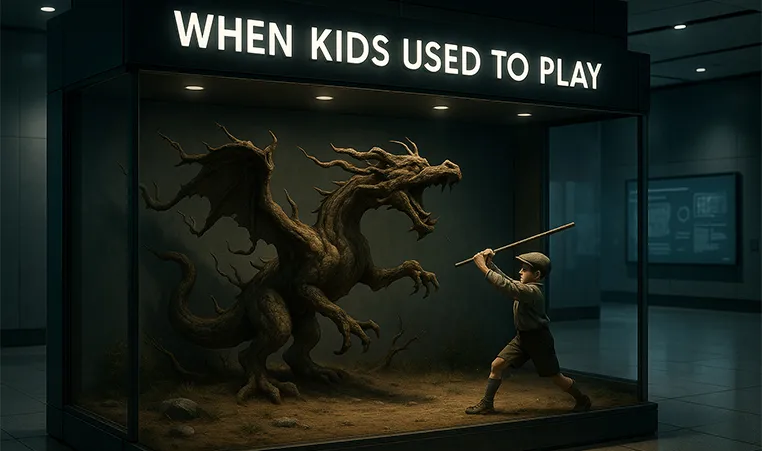
Parents, imagine you're in a museum, and you come across an exhibit called "When Kids Used to Play."
In it, you see a kid using a stick as a sword, slaying a dragon that is actually just the old tree in the backyard.
This seems absurd, but not impossible if some of the screen time trends continue.
This blog offers friendly tips on how we can stop this exhibit from ever being built, and how we can help kids narrate their own adventures, not just watch someone else’s unfold on a screen.
Let's Start With Some Numbers.
- 2 in 3 parents want to reduce their child's screen time. [1]
- Kids in the U.S. under the age of 12 spend 4–6 hours per day on screens. [3]
Why Are Kids So Glued To Their Screens?
The Dopamine Hit
Digital devices, like tablets and phones, are jam-packed with dopamine-releasing notifications, rewards, and content pieces.
Apps on these devices are specifically designed to trigger the brain's reward system, much like other addictive substances.
This is why many kids—and adults— struggle to put their devices down.
Emotional Coping
Kids may use screen time to escape boredom, loneliness, or negative feelings.
Peer Influence
Devices allow kids to connect with their friends at any time, from anywhere, making many social media apps feel "essential."
What Are the Consequences of Too Much Screen Time?
It’s not about removing screens — it’s about reclaiming play. Screen time is not altogether "bad."
However, excessive screen time does not allow as much time for kids to move, interact, and develop critical skills through real-world experiences.
Health Impacts
More screen time leads to less physical activity.
Kids who don't meet daily activity recommendations are more likely to develop poor sleep habits and reduced overall health.
Social and Emotional Development
Screen time reduces face-to-face interactions for kids. These interactions are vital for learning language and reading social cues.
Behavioral Effects
In a 2021 study, children who spent 3 hours or more on screens had an increased chance of behavioral problems, delayed developmental milestones, and poorer vocabulary. [2]
Why is Active Play Important?
Social Benefits
- Opportunities to collaborate with peers
- Enhanced empathy
- Understanding of shared rules, roles, and responsibilities.
Emotional Benefits
- Healthy outlet for frustration and stress
- Builds confidence and self-esteem
Physical Benefits
- Strengthens muscles and cardiovascular health
- Improves coordination and balance
- Supports healthy sleep
Small Steps to Shift From Screen Time to Play Time
Model Active Behavior
Participating enthusiastically in active play will inspire your kids to do the same.
Set Clear Rules
Set consistent limits on screen time and communicate expectations clearly.
Help Your Child Understand the Consequences
Invite your child to choose. Explain to them that an hour spent on the screen means one less hour enjoying time with their family.
Take Family Walks
Walking is an easy, approachable workout. Make these walks a daily or weekly routine to make physical activity enjoyable and social for the whole family.
Active Breaks
Add fun movement breaks between homework or chores — even 5 minutes makes a difference.
The YMCA Difference: Making Active Play Easy for Families
The Kandiyohi County Area Family YMCA is here to help reintroduce active play for Willmar area families in a positive, welcoming setting.
The YMCA offers plenty of space for families to get moving together, including two gyms, a pool, and fitness centers.
YMCA Youth Sports programs offer a non-competitive starting point for kids of all skill levels.
Our coaches aren't focused on wins and losses. They're here to inspire your kids to develop healthy habits, build their skills, and have fun.
Let’s Make Sure ‘Play’ Never Becomes a Museum Exhibit
Someday, when your child looks back, they won’t remember their favorite app — they’ll remember the games you played and the time you spent together.
At the YMCA, we’re here to make that easier. From open gyms and family swim times to youth sports programs that build confidence through play, the Y helps families reclaim what matters most: time together.
Because childhood should be lived — not just watched on a screen.
Sources
[1] Lurie Children’s Hospital of Chicago. (2025, July 22). Screen time statistics reveal how parents use screens as babysitters, educators, and entertainment tools. https://www.luriechildrens.org/en/blog/screen-time-2025/
[2] McArthur, B.A., Tough, S. & Madigan, S. Screen time and developmental and behavioral outcomes for preschool children. Pediatr Res 91, 1616–1621 (2022). https://doi.org/10.1038/s41390-021-01572-w
[3] Tenety, E. (2025, March 5). Screen time for kids: How much is too much in 2025? Motherly. https://www.mother.ly/child/child-learn-play/screen-time-for-kids-statistics-2025/